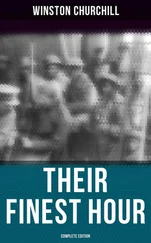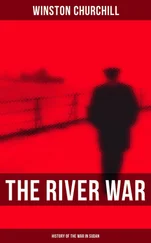Winston Churchill - Ian Hamilton's March
Здесь есть возможность читать онлайн «Winston Churchill - Ian Hamilton's March» весь текст электронной книги совершенно бесплатно (целиком полную версию без сокращений). В некоторых случаях можно слушать аудио, скачать через торрент в формате fb2 и присутствует краткое содержание. Год выпуска: 2018, Издательство: epubBooks Classics, Жанр: История, Прочая документальная литература, на английском языке. Описание произведения, (предисловие) а так же отзывы посетителей доступны на портале библиотеки ЛибКат.
- Название:Ian Hamilton's March
- Автор:
- Издательство:epubBooks Classics
- Жанр:
- Год:2018
- ISBN:нет данных
- Рейтинг книги:4 / 5. Голосов: 1
-
Избранное:Добавить в избранное
- Отзывы:
-
Ваша оценка:
- 80
- 1
- 2
- 3
- 4
- 5
Ian Hamilton's March: краткое содержание, описание и аннотация
Предлагаем к чтению аннотацию, описание, краткое содержание или предисловие (зависит от того, что написал сам автор книги «Ian Hamilton's March»). Если вы не нашли необходимую информацию о книге — напишите в комментариях, мы постараемся отыскать её.
London to Ladysmith
Ian Hamilton's March — читать онлайн бесплатно полную книгу (весь текст) целиком
Ниже представлен текст книги, разбитый по страницам. Система сохранения места последней прочитанной страницы, позволяет с удобством читать онлайн бесплатно книгу «Ian Hamilton's March», без необходимости каждый раз заново искать на чём Вы остановились. Поставьте закладку, и сможете в любой момент перейти на страницу, на которой закончили чтение.
Интервал:
Закладка:
Gatacre had a post at Dewetsdorp: three companies of the Royal Irish Rifles, two of Mounted Infantry. So soon as he heard of the retirement of the Ninth Division he sent orders by many routes for his post to fall back too. They fell back accordingly; but at Reddersburg the net closed round them. Let us judge no man harshly or in ignorance. Fighting followed. With a loss of eight killed and thirty–one wounded, the retreating troops surrendered when relief was scarcely five miles away. Everything curled back on to Bloemfontein and the railway line, which it was vital to hold. Reinforcements were thrust to the front to meet the emergency: Rundle, with the Eighth Division, was diverted from Kimberley to Springfontein; Hunter, with the Tenth Division (our old friends the Irish and Fusilier Brigades), started from Natal, thus condemning Buller to the strict defensive, and the Boers swept southward.
Now, in accordance with the terms of Lord Roberts's Proclamation, many farmers of the Free State, fighting men of the Boer Army—that is to say, who had thought that all was up: deserters, in other words—had come into the British posts, made their submission, taken the oath, and returned to their farms. The Boers were very angry with these people. What protection could we give them? Some, it is said—it may be a lie—were shot by the enemy. Most of them, from fear or inclination, rejoined their commandos.
The whole of the right–hand bottom corner of the Free State was overrun. Southward still hastened the Boer forces. Brabant was the next to feel the tempest. His garrison in Wepener was assailed, surrounded, fought well—perhaps is now fighting desperately. Other Boers approached the rebel districts of Cape Colony. The lately penitent rebels stirred, are stirring.
Mark, by the way, this sedition is not the result of misplaced generosity but of military misfortunes. No one expects beaten men to be grateful; but, under certain conditions, they will be loyal. An enemy at their throats is not one of those conditions. Southward still sweep the commandos with empty carts , for this is the most fertile of all the Republican territories; and, in the meanwhile, what are we doing? Divisions and brigades are being moved by a strong yet deliberate hand. The hope—general and special idea in one—is to catch these bold fellows who have thrust their heads thus far into the lion's mouth and enjoyed until now such immunity. Wepeper making a brave defence; Brabant marching through Rouxville to bar their advance; Rundle, Chermside, and Brabazon striking east from Edenburg to shut the door behind them with two Infantry divisions, twenty–four guns, and 2,000 Yeomanry; and, further north, the great Bloemfontein Army—four Infantry divisions, Hamilton's 10,000 mounted men, French's four Cavalry brigades, and many guns—is almost ready to move. Assuredly these Boers are in a dangerous place. Will they escape? Will they, perhaps, carry some part of the intercepting lines with them as a trophy of victory? 'Qui vivra verra,' and, if these letters continue, 'who runs may read,' for I purpose to journey viâ Edenburg to Reddersburg to–morrow, and thence on to the point of collision, which must mark the climax of this extremely interesting event henceforward to be called 'The Operations in the Right–hand Bottom Corner of the Free State.'
Chapter IV
Two Days With Brabazon
Before Dewetsdorp: April 21.
When the incursion of the Boers into the recently pacified districts became known, the Eighth Division (Rundle) was diverted from Kimberley, whither it was proceeding, and concentrated at Springfontein. The Third Division (Chermside, in supersession of Gatacre) massed at Bethany. Still more troops were needed to guard the line and clear the country.
Sir Redvers Buller was asked whether he could co–operate by forcing Van Reenen's Pass and bringing pressure on the enemy's line of retreat. His position in the centre of the triangle of Natal was, however, an inconvenient one. The strategic advantages possessed by the Boers in this scene of the war have before been noticed. But it may be worth while to explain them again.
The enemy possess the superiority of an enveloping frontier. If Sir Redvers Buller moves west through Van Reenen's Pass to make the diversion required in the Free State, down will come the Boers from the Biggarsburg on his communications and into South Natal. If he moves north to attack the Biggarsburg positions in order to clear Natal he will cut the Boers on his left flank and line.
According to the best information there are three thousand Boers on the Drakensburg Passes, and ten thousand on the Biggarsburg. Buller, therefore, would have preferred to mask Van Reenen's with the Ladysmith Division (Fourth, Lyttelton), which was getting well and strong again, and move northwards with the Second, Fifth, and Tenth Divisions. He did not consider until northern Natal should be cleared that he could safely move westward. On the other hand, the need in the Free State was urgent, and it was therefore arranged that the Tenth Division (Hunter) should come by sea to East London—one brigade to replace the division diverted from Kimberley, one brigade to Bethulie, and that the rest of the Natal Field Army should remain strictly on the defensive until the situation was materially altered.
Practically, therefore, five brigades of troops were available for the operations in the right–hand bottom corner: Hart, with a brigade of Hunter's Division at Bethulie, the Third and Eighth Divisions under Chermside and Rundle at Springfontein and Bethany. Besides these powerful bodies, which were quite independent of the communication troops or the Bloemfontein Army, there were fourteen hundred Yeomanry and Mounted Infantry under General Brabazon, and Brabant's Colonial Brigade, about two thousand five hundred strong.
It is scarcely necessary to follow all the movements in exact detail. Rundle formed a column at Edenburg, and, marching to Reddersburg, joined his force to part of Chermside's Division from Bethany, thus having under his immediate command eight battalions, four batteries, and Brabazon's Mounted Brigade. Another brigade was collecting at Edenburg under Campbell. Hart was moved north–east towards Rouxville, where was also Brabant with a thousand horse. The rest of Brabant's force, some fifteen hundred strong, were blockaded in Wepener by the enemy. Such was the situation when I left Bloemfontein on the morning of the 17th.
I travelled prosperously; came by rail to Edenburg, trekked from there in drenching rains, most unusual for this time of year, and greatly increasing the difficulties of supply; and, resting for the night at Reddersburg, caught up the marching column in its camp, about eleven miles from Dewetsdorp, on the night of the 19th.
The position of the various troops was then as follows: Rundle, with eight battalions, four batteries, and fifteen hundred horse at Oorlogs Poorte, about twelve miles from Dewetsdorp; Campbell, with two battalions and a battery near Rosendal, marching to join him; the Grenadier Guards double marching through Reddersburg to catch up the main force; Hart, with four battalions in Rouxville; Brabant, with one thousand horsemen eight miles north of Rouxville; Dalgety, with a garrison of fifteen hundred men, holding Wepener.
Operations in the O.F.S. April, 1900.
So far as could be learned the enemy had about seven thousand men with twelve guns south of the Bloemfontein–Thabanchu line under Commandants Olivier and De Wet, and with this force, which made up in enterprise and activity what it lacked in numbers or material, they were attempting to blockade and attack Wepener, to bar the road of Rundle's column to Dewetsdorp, and to check Brabant and Hart at Smithfield. Besides proposing this ambitious programme, the Boers sent their patrols riding about the country commandeering all pacified farmers under threats of death.
Читать дальшеИнтервал:
Закладка:
Похожие книги на «Ian Hamilton's March»
Представляем Вашему вниманию похожие книги на «Ian Hamilton's March» списком для выбора. Мы отобрали схожую по названию и смыслу литературу в надежде предоставить читателям больше вариантов отыскать новые, интересные, ещё непрочитанные произведения.
Обсуждение, отзывы о книге «Ian Hamilton's March» и просто собственные мнения читателей. Оставьте ваши комментарии, напишите, что Вы думаете о произведении, его смысле или главных героях. Укажите что конкретно понравилось, а что нет, и почему Вы так считаете.











